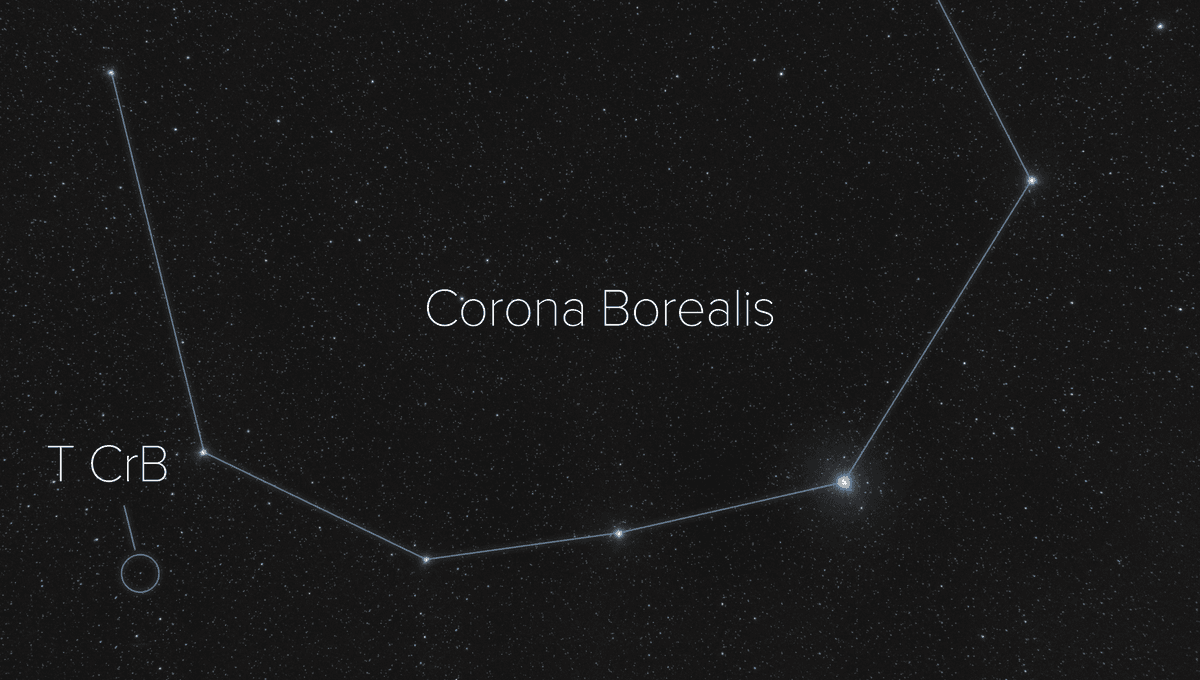
Sometime soon, the reoccurring nova T Coronae Borealis is expected to brighten almost ten thousand-fold – but astronomers who have been anxiously watching for this exciting event would suddenly like a delay. The reason is that the Sun is now approaching Libra, the closest zodiacal constellation to Corona Borealis, meaning that if the event happens now, it will be invisible from much of the planet.
Novae are overshadowed by their more dramatic counterparts with super in front of the name, but they’re still treasured astronomical events. They occur when a white dwarf and main sequence star, often a red giant, are in tight orbits around each other, and the intense gravity of the white dwarf pulls gas off its less dense counterpart. Once enough gas falls on the white dwarf, fusion initiates, causing a sudden surge in brightness.
Some novae occur unpredictably and may not repeat for centuries, if at all, but a few recurrent novae happen at relatively regular intervals. Unfortunately, most of these are so far away that even at their brightest it takes a telescope to see them.
T Coronae Borealis is unique, a repeating nova that gets bright enough to see with the naked eye, even from the outskirts of cities, earning it the nickname the Blaze Star. Unfortunately, where other recurring novae happen every 38 or even 15 years, there is an approximately 80-year gap between this one’s explosions. At least we think there is; we only know of two outbursts for sure, in 1866 and 1946, although we have grounds to suspect others in 1217 and 1787.
Specialists in the area have been looking forward to a repeat for a while, and in 2023 when Professor Bradley Schaefer of Louisiana State University predicted it would occur between February and September this year, excitement rose. A NASA post regarding the prediction was picked up by news outlets worldwide, whose reports have been collectively read tens of millions of times.
Schaefer’s window has now closed. The majority of the reporting on his paper contained a serious misunderstanding, presenting his work as if such an explosion in the period he described was a certainty. In reality, Schaefer himself acknowledged there was room for doubt, and the February-September period he referred to was just the most likely time for the event.
As Dr Gerard van Belle of the Lowell Observatory put it to IFLScience back in July: “Predictions in astronomy tend to fall in two categories, either extremely precise – eg. when is an eclipse going to occur, down the second? – or wildly imprecise – maybe tomorrow, or maybe in a year? This particular event is in the latter category. ‘Prior to September’ is by no means a certainty. Past performance of this particular object seems to indicate it’s rather likely (at the >75% confidence level or so?) to be before then but not certain – yes, it could wait until next year.” It hasn’t stopped stories circulating literally predicting it “any day now”.
A few astronomers are now questioning if the explosion will happen at all. Most of those expressing an opinion on the topic however, think an event is still likely to come relatively soon.
On the other hand, where once astronomers were looking forward to the event with enthusiasm, things are now a little more complicated.
Schaeffer’s anticipated timing suited observations, and astronomers, both amateur and professional, desperately hoped he would be right. For amateur astronomers, such an explosion would make the night skies even more beautiful for around a week, and be a chance to tick something off their bucket-list. For professionals, instruments have advanced immensely since 1946, and there are numerous tests they are itching to do to understand the processes of a reoccurring nova and learn about the stars involved.
All that depends, however, on being able to see it. The anticipated explosion is likely to be at peak brightness for a week, so any one location might miss it with lousy weather, but most would be luckier. It’s a different matter when the Sun blocks our view.
Already, T Coronae Borealis is effectively impossible to see from the Southern Hemisphere. It lies at celestial latitude of 26 North, so it’s always above the horizon for less time in the south than the north. That time currently coincides with daylight, or at least twilight, and that’s going to be the case until roughly January (with some variation depending on how far south you are).
Most astronomers, and most telescopes, are in the Northern Hemisphere, but even there the blaze star is currently at its highest during daylight. By the time it gets dark, it’s uncomfortably low in the sky. You have to go a long way north – further north than any of the world’s best telescopes – before viewing T Coronae Borealis in October/November won’t be a challenge.
Consequently, while enthusiasm for the event remains high, it would be nice, having kept us waiting for most of this year, if the anticipated spectacle can wait a little longer.
Source Link: Why Astronomers Have Stopped Hoping For A Once-In-A-Lifetime Exploding Star (For Now)